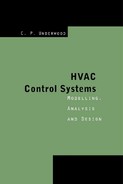Book Description
This important new book bridges the gap between works on classical control and process control, and those dealing with HVAC control at a more elementary level, which generally adopt a qualitative and descriptive control. Both advanced level students and specialist practitioners will welcome the in-depth analytical treatment of the subject presented in this volume. Of particular significance are the current developments in adaptive control, robust control, artificial neural networks and fuzzy logic systems, all of which are given a thorough analytical treatment in the book.
- First book to provide an analytical treatment of subject
- Covers all new developments in HVAC control systems
- Looks at systems both in the UK and abroad
Book Description
This important new book bridges the gap between works on classical control and process control, and those dealing with HVAC control at a more elementary level, which generally adopt a qualitative and descriptive control. Both advanced level students and specialist practitioners will welcome the in-depth analytical treatment of the subject presented in this volume. Of particular significance are the current developments in adaptive control, robust control, artificial neural networks and fuzzy logic systems, all of which are given a thorough analytical treatment in the book.
- First book to provide an analytical treatment of subject
- Covers all new developments in HVAC control systems
- Looks at systems both in the UK and abroad
Table of Contents
- Cover
- Title page
- Copyright page
- Dedication page
- Contents
- Preface
- Acknowledgements
- 1 HVAC control systems
- 1.1 Basic concepts
- 1.2 HVAC control strategies
- 1.3 Distributed control
- 1.4 System configuration
- References
- 2 Device technology
- 2.1 Sensors
- 2.2 Control elements
- 2.3 PID (proportional/integral/derivative) controllers
- References
- 3 System modelling
- 3.1 Simple room modelling for control analysis
- 3.2 Accounting for fabric in room modelling
- 3.3 Heat emitter and non-linear modelling
- 3.4 A coupled room and emitter model
- 3.5 Component modelling
- References
- 4 System stability
- 4.1 Feedback control
- 4.2 Stability tests
- 4.3 Feedforward control
- 4.4 Model reduction
- References
- 5 Discrete-time systems
- 5.1 The z-transform
- 5.2 Representing discrete-time systems
- 5.3 Stability tests in discrete-time systems
- 5.4 The sampling interval
- 5.5 Digital control algorithms
- References
- 6 Multivariable control
- 6.1 State-space representation of systems
- 6.2 The transfer function matrix
- 6.3 The multivariable control problem
- 6.4 Design of multivariable compensators
- References
- 7 System identification and controller tuning
- 7.1 System identification
- 7.2 Assessing the quality of response
- 7.3 Fixed-parameter controller tuning methods
- References
- 8 Adaptive control
- 8.1 Adaptive controllers
- 8.2 Direct and indirect adaptive control algorithms
- 8.3 Model-reference adaptive control
- 8.4 Gain scheduling
- 8.5 Progress in HVAC adaptive control
- References
- 9 Advanced methods
- 9.1 Robust control
- 9.2 Expert systems
- 9.3 Fuzzy logic control
- 9.4 Artificial neural networks
- References
- Index
